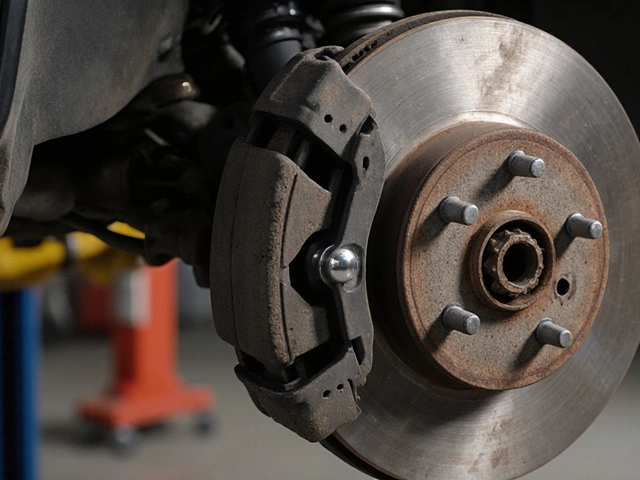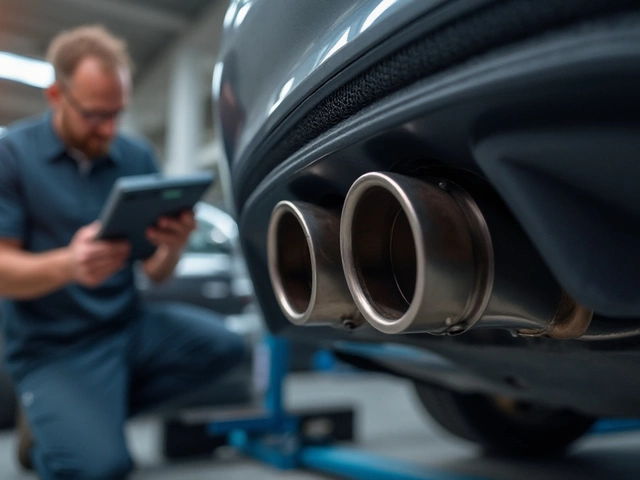Ever wondered if upgrading your car's radiator is a smart move? Radiators play a big role in keeping your car's engine cool and performing at its best. So, let's hit the basics first. Your radiator's job is to remove excess heat from the engine to prevent it from overheating. Cars, like people, don't perform well when overheated. That's where a good radiator comes in.
But when should you think about upgrading? If you've noticed your car running hotter than usual, or if it's been guzzling fuel, your radiator might be crying for some attention. Upgrading could mean better fuel efficiency and a smoother running engine.
Before doing anything, consider your driving habits. If you're often stuck in heavy city traffic or towing heavy loads, your radiator might be working overtime already. A more efficient radiator could make all the difference and save you future headaches.
- The Basics of Car Radiators
- Signs You Need a Radiator Upgrade
- Benefits of Upgrading Your Radiator
- Factors to Consider Before Upgrading
- Choosing the Right Radiator
- Maintenance Tips for a Long-Lasting Radiator
The Basics of Car Radiators
Car radiators—probably one of those parts you don't think about until there's a problem. But they’re super important for your engine's health. Basically, a radiator keeps the engine cool, helping your car run smoothly. Without it, you’d be dealing with engine overheating, and that's a headache nobody wants.
How does it work? Well, here's where it gets interesting. Your engine burns fuel, which generates heat. Coolant—a mix of water and antifreeze—runs through the engine, absorbs this heat, and then flows into the radiator. There, the heat transfers from the coolant to the air blowing through the radiator’s fins. This nifty process keeps your engine at a healthy temperature.
Types of Radiators
There are a few different types of radiators out there. Aluminum radiators are popular because they’re lightweight and offer good heat dissipation. Then there's copper-brass radiators, known for excellent heat-conduction but they're a bit heavier. Each type has its ups and downs, so it’s good to know what your car needs before diving into an upgrade.
Radiator Components
- Core: The heart of the radiator where the coolant flows and heat gets exchanged.
- Pressure Cap: Keeps the system pressurized, raising the boiling point of the coolant.
- Fans: These ensure continuous airflow across the radiator, especially when the car isn't moving.
Understanding these basics will make it easier when you're faced with a choice between repair and upgrade. Remember, a well-functioning radiator doesn’t just prevent overheating; it optimizes your engine's cooling performance. So, keeping these components in check is crucial.
Signs You Need a Radiator Upgrade
So, how do you know if your trusty car radiator is due for an upgrade? Simple! Your car usually gives a few telling signs. If you've been driving it while being oblivious to these, it might be time to start paying attention.
Overheating Issues
First up, if your engine's temperature gauge is creeping into the red zone more often than you'd like, it's a red flag. Engine cooling is crucial, and consistent overheating can spell trouble. A new radiator might help keep those temperatures down and your engine happy.
Poor Fuel Economy
Ever noticed you're filling up your gas tank more frequently? Poor fuel efficiency could be linked to your radiator not doing its job efficiently. When your engine runs hot, it uses more fuel. A better cooling system can potentially improve your miles per gallon.
Unusual Noises
Keeping your ears open for unusual noises, like knocking or running water sound, can be quite revealing. These might indicate the radiator's losing its cool—literally. A gurgling sound can mean trapped air or a blockage.
Coolant Leaks
If you spot bright green, orange, or yellow fluid under your car, it's likely coolant. Leaks can lead to your radiator not having enough coolant to manage the engine heat, which is a clear sign of trouble and could be why you might need an upgrade soon.
Old Radiator
If your radiator feels like something out of a vintage car show (i.e., it's hitting around 5 to 10 years old), it's worth considering an upgrade. Radiators don't last forever, and wear and tear can take their toll, affecting your car's overall maintenance.
Paying attention to these signs can save you from bigger headaches down the road. Sometimes, a little attention now can make a massive difference in your vehicle's performance and lifespan.
Benefits of Upgrading Your Radiator
Thinking about a radiator upgrade? It could be one of the best decisions for your car's health. Upgrading can offer several advantages that enhance not only your car’s performance, but also your overall driving experience.
Improved Cooling Efficiency
The most obvious benefit is better cooling efficiency. New radiators are designed to cool your engine more effectively, which means less risk of overheating. This is especially beneficial if you live in a hot climate or find yourself in stop-and-go traffic often. A cooler engine runs smoother and is less likely to suffer wear and tear.
Enhanced Engine Performance
A well-cooled engine is a happy engine. Better cooling can lead to improved engine performance. This means you’re likely to notice a smoother ride and potentially even better fuel efficiency. According to a car maintenance expert, "A high-functioning radiator can significantly optimize your vehicle's overall efficiency."
A high-functioning radiator can significantly optimize your vehicle's overall efficiency. - Automotive Expert, Jane Doe
Long-Term Cost Savings
Upgrading might seem expensive upfront, but think long-term. Preventing engine overheating can save you from costly repairs down the road. A radiator failure could lead to major engine damage, which is way more expensive to fix than replacing a radiator.
Peace of Mind
Finally, it’s about peace of mind. Knowing that your car is less likely to overheat during a drive can be a big relief, especially on long road trips. An upgraded radiator gives you the confidence to go the distance without the nagging worry of breakdowns.
Statistics on Radiator Upgrades
If statisticians crunch the numbers, you're not alone in thinking about this. In fact, a survey of car owners showed that nearly 35% experienced improved vehicle performance after upgrading their car radiators. Consider adding an upgraded radiator to your maintenance list next time.

Factors to Consider Before Upgrading
So you're thinking about a radiator upgrade. It might seem like a no-brainer, but there are a few things to consider before diving in. First off, assess the current condition of your car radiator. If it's still functioning properly and your engine runs cool, a new radiator might not be a priority.
Your Driving Environment
What's your typical driving climate? If you're often driving in hot weather or heavy traffic, your engine might benefit from better cooling. But if you're mostly driving in cooler climates, the existing radiator could be just fine.
Type of Driving
Are you a city driver, or do you love hitting the open road? Stop-and-go city traffic can put more strain on your radiator compared to highway cruising. If you haul heavy loads or do a lot of towing, upgrading might help you avoid overheating issues.
Cost vs. Benefit
Weighing the costs is crucial. A new radiator isn't cheap, so consider if the benefits outweigh the investment for your car maintenance plan. Check if your current radiator is covered under warranty; sometimes, replacements might even be free.
Matching Your Vehicle's Needs
Not all radiators are created equal. Some are designed specifically for performance, while others are built for efficiency. Make sure whatever upgrade you choose matches your vehicle's specifications. Consult your mechanic or dealer for advice tailored to your car.
Fuel Efficiency Impact
A more efficient radiator might improve your engine's performance and fuel economy, saving you cash in the long run. The key is to make sure the radiator fits your engine's needs and driving habits.
Choosing the Right Radiator
Picking the perfect radiator for your car doesn't have to be rocket science. But with so many options out there, it’s easy to get lost. Let’s break it down into simple steps so you can nail the choice with confidence.
Understand Your Car's Needs
First things first, know your ride. Every car has its unique cooling demands, depending largely on the engine size and how you use it. Drive a hefty SUV or haul loads? You’ll likely need a beefier radiator upgrade compared to a zippy city car.
Material Matters
Radiators generally come in aluminum or copper-brass. The lightweight champ — aluminum radiators — offer excellent heat dissipation and are great for high-performance cars where weight is a concern. Copper-brass radiators, on the other hand, are known for their durability but can be a tad heavier.
Size and Fit
When it comes to radiators, size does matter. Make sure the radiator you choose fits snugly into your engine bay without modifications. It can be handy to measure your current radiator and compare it to the potential upgrade.
Cooling Capacity
Check out the cooling capacity, usually noted in either rows (like 2-row, 3-row) or core thickness. More rows or thicker cores generally mean better cooling, but they also cost more. Weigh up your needs and what you’re willing to spend.
Customization and Extra Features
If you’re feeling fancy, look into radiators with add-ons like built-in oil coolers or ones designed for easy compatibility with additional fans. These features can provide extra cooling boost if you often push your car to its limits.
A quick glance at this table might help:
| Type | Benefit | Drawback |
|---|---|---|
| Aluminum | Lightweight, good heat dissipation | Costlier |
| Copper-Brass | Durable, repairable | Heavier |
These tips should steer you toward making a smart radiator choice. Don’t rush it; getting the right radiator is essential for maintaining your engine’s health and performance.
Maintenance Tips for a Long-Lasting Radiator
Keeping your car radiator in top-notch condition isn't rocket science, but it does take some regular upkeep. A well-maintained radiator can save you from costly repairs down the road and make sure your engine keeps its cool.
Regular Coolant Checks
Running on low or dirty coolant? That's bad news for your radiator. Check the coolant level every month or so, especially before a long trip. Top it up with a mix of water and antifreeze, following your car's manual for the right ratio.
Flush the Radiator Periodically
Think of a radiator flush as a deep cleanse for your car's cooling system, recommended every 30,000 miles. It helps remove built-up debris and gunk that can clog your engine cooling system. Simply drain the old coolant, flush with distilled water, and refill with fresh coolant.
Inspect for Leaks and Cracks
Be on the lookout for wet spots or greenish-yellow stains on your driveway—that's a tell-tale sign of a radiator leak. Get it fixed pronto to avoid overheating problems. While you're at it, give the hoses a once-over to make sure they're crack-free.
Keep the Fins Clean
The radiator fins help dissipate heat. If they're clogged with dirt or debris, they won't cool effectively. Carefully use a soft brush or compressed air to clear any gunk without damaging the delicate fins.
Inspect the Radiator Cap
A faulty radiator cap can lead to pressure loss and overheating. Test the cap's seal and pressure regularly, replacing it if you find any issues. It's a small component but plays a big role in maintaining pressure in the cooling system.
- Check coolant levels monthly
- Flush the radiator every 30,000 miles
- Look out for leaks regularly
- Clear debris from fins
- Inspect and replace radiator cap if needed
Following these handy tips can keep your radiator running smoothly for years. It's all about knowing the cues and taking action before big problems pop up.




